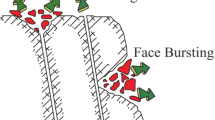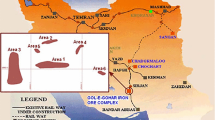Abstract
This study introduces a new model to determine the critical flyrock event in mines. The flyrock was predicted and optimized using a field database including six parameters and 240 blasting events. The human learning optimization (HLO) algorithm was used in this research to optimize the support vector regression (SVR) function. Given different coefficients of kernels, optimization process minimized the likelihood of error in the models, allowing them to be detected and performed with the greatest precision. This procedure was repeated until the best model was discovered. Eventually, the radial basis function kernel was chosen for evaluating flyrock because it received the lowest computational error and the highest model accuracy. This model provided coefficient of determination (R2) = 0.9372 and R2 = 0.9294, respectively, as the accuracy for training and testing results. This function was considered as a relationship that the HLO algorithm could use to find the best options (i.e., optimal condition) under various conditions. The findings for 14 cases that are the essential examples in this study indicated that the optimal states are found with a great precision. The variation of the results obtained from optimization with real values is less than 5%. This demonstrates that a suitable model can be developed by employing the HLO algorithm in the development of the predictive related models to blasting and rock mechanics.
















Similar content being viewed by others
References
Aghaabbasi M, Shekari ZA, Shah MZ et al (2020) Predicting the use frequency of ride-sourcing by off-campus university students through random forest and Bayesian network techniques. Transp Res Part A Policy Pract 136:262–281
Apostolopoulou M, Asteris PG, Armaghani DJ et al (2020) Mapping and holistic design of natural hydraulic lime mortars. Cem Concr Res 136:106167
Armaghani DJ, Mahdiyar A, Hasanipanah M et al (2016) Risk assessment and prediction of flyrock distance by combined multiple regression analysis and monte carlo simulation of quarry blasting. Rock Mech Rock Eng 49:1–11. https://doi.org/10.1007/s00603-016-1015-z
Armaghani DJ, Koopialipoor M, Bahri M et al (2020) A SVR-GWO technique to minimize flyrock distance resulting from blasting. Bull Eng Geol Environ. https://doi.org/10.1007/s10064-020-01834-7
Armaghani DJ, Mamou A, Maraveas C et al (2021) Predicting the unconfined compressive strength of granite using only two non-destructive test indexes. Geomech Eng 25:317–330
Asteris PG, Apostolopoulou M, Skentou AD, Moropoulou A (2019) Application of artificial neural networks for the prediction of the compressive strength of cement-based mortars. Comput Concr 24:329–345
Bajpayee TS, Rehak TR, Mowrey GL, Ingram DK (2004) Blasting injuries in surface mining with emphasis on flyrock and blast area security. J Safety Res 35:47–57
Cortes C, Vapnik V (1995) Support vector machine. Mach Learn 20:273–297
Faradonbeh RS, Jahed Armaghani D, Monjezi M (2016) Development of a new model for predicting flyrock distance in quarry blasting: a genetic programming technique. Bull Eng Geol Environ. https://doi.org/10.1007/s10064-016-0872-8
Ghezelbash R, Maghsoudi A, Carranza EJM (2019) Performance evaluation of RBF-and SVM-based machine learning algorithms for predictive mineral prospectivity modeling: integration of SA multifractal model and mineralization controls. Earth Sci Informatics 12:277–293
Gui G, Pan H, Lin Z et al (2017) Data-driven support vector machine with optimization techniques for structural health monitoring and damage detection. KSCE J Civ Eng 21:523–534
Guo H, Zhou J, Koopialipoor M et al (2019) Deep neural network and whale optimization algorithm to assess flyrock induced by blasting. Eng Comput. https://doi.org/10.1007/s00366-019-00816-y
Hasanipanah M, Faradonbeh RS, Armaghani DJ et al (2017) Development of a precise model for prediction of blast-induced flyrock using regression tree technique. Environ Earth Sci 76:27
Huang L, Asteris PG, Koopialipoor M et al (2019) Invasive weed optimization technique-based ANN to the prediction of rock tensile strength. Appl Sci 9:5372
Huang J, Duan T, Zhang Y et al (2020a) Predicting the permeability of pervious concrete based on the beetle antennae search algorithm and random forest model. Adv Civ Eng 20:20
Huang J, Koopialipoor M, Armaghani DJ (2020b) A combination of fuzzy Delphi method and hybrid ANN-based systems to forecast ground vibration resulting from blasting. Sci Rep 10:1–21
Huang J, Kumar GS, Sun Y (2021a) Evaluation of workability and mechanical properties of asphalt binder and mixture modified with waste toner. Constr Build Mater 276:122230
Huang J, Sun Y, Zhang J (2021b) Reduction of computational error by optimizing SVR kernel coefficients to simulate concrete compressive strength through the use of a human learning optimization algorithm. Eng Comput. https://doi.org/10.1007/s00366-021-01305-x
Huang J, Zhang Y, Sun Y et al (2021c) Evaluation of pore size distribution and permeability reduction behavior in pervious concrete. Constr Build Mater 290:123228
Jahed Armaghani D, Hasanipanah M, Mahdiyar A et al (2016a) Airblast prediction through a hybrid genetic algorithm-ANN model. Neural Comput Appl. https://doi.org/10.1007/s00521-016-2598-8
Jahed Armaghani D, Tonnizam Mohamad E, Hajihassani M et al (2016b) Evaluation and prediction of flyrock resulting from blasting operations using empirical and computational methods. Eng Comput. https://doi.org/10.1007/s00366-015-0402-5
Kennedy J (2011) Particle swarm optimization. Encyclopedia of machine learning. Springer, Berlin, pp 760–766
Koopialipoor M, Armaghani DJ, Hedayat A et al (2018a) Applying various hybrid intelligent systems to evaluate and predict slope stability under static and dynamic conditions. Soft Comput. https://doi.org/10.1007/s00500-018-3253-3
Koopialipoor M, Fallah A, Armaghani DJ et al (2018b) Three hybrid intelligent models in estimating flyrock distance resulting from blasting. Eng Comput. https://doi.org/10.1007/s00366-018-0596-4
Koopialipoor M, Noorbakhsh A, Noroozi Ghaleini E et al (2019) A new approach for estimation of rock brittleness based on non-destructive tests. Nondestruct Test Eval. https://doi.org/10.1080/10589759.2019.1623214
Kurnaz TF, Kaya Y (2019) A novel ensemble model based on GMDH-type neural network for the prediction of CPT-based soil liquefaction. Environ Earth Sci 78:339
Li D, Koopialipoor M, Armaghani DJ (2021) A combination of fuzzy delphi method and ANN-based models to investigate factors of flyrock induced by mine blasting. Nat Resour Res. https://doi.org/10.1007/s11053-020-09794-1
Liu B, Yang H, Karekal S (2019) Effect of water content on argillization of mudstone during the tunnelling process. Rock Mech Rock Eng. https://doi.org/10.1007/s00603-019-01947-w
Lu S, Koopialipoor M, Asteris PG et al (2020) A Novel feature selection approach based on tree models for evaluating the punching shear capacity of steel fiber-reinforced concrete flat slabs. Materials (basel) 13:3902
Lundborg N (1974) The hazards of flyrock in rock blasting. Swedish Detonic Res Found Rep DS 12:2
Lundborg N, Persson A, Ladegaard-Pedersen A, Holmberg R (1975) Keeping the lid on flyrock in open-pit blasting. Eng Min J 176:95–100
Mahdiyar A, JahedArmaghani D, Koopialipoor M et al (2020) Practical risk assessment of ground vibrations resulting from blasting, using gene expression programming and monte carlo simulation techniques. Appl Sci 10:472
Momeni E, Dowlatshahi MB, Omidinasab F et al (2020) Gaussian process regression technique to estimate the pile bearing capacity. Arab J Sci Eng 45:8255–8267. https://doi.org/10.1007/s13369-020-04683-4
Monjezi M, Mehrdanesh A, Malek A, Khandelwal M (2013) Evaluation of effect of blast design parameters on flyrock using artificial neural networks. Neural Comput Appl 23:349–356
Monjezi M, Rizi SMH, Majd VJ, Khandelwal M (2014) Artificial neural network as a tool for backbreak prediction. Geotech Geol Eng 32:21–30
Murlidhar BR, Kumar D, Jahed Armaghani D et al (2020) A novel intelligent ELM-BBO technique for predicting distance of mine blasting-induced flyrock. Nat Resour Res. https://doi.org/10.1007/s11053-020-09676-6
Nguyen H (2019) Support vector regression approach with different kernel functions for predicting blast-induced ground vibration: a case study in an open-pit coal mine of Vietnam. SN Appl Sci 1:283
Nguyen H, Choi Y, Bui X-N, Nguyen-Thoi T (2020) Predicting blast-induced ground vibration in open-pit mines using vibration sensors and support vector regression-based optimization algorithms. Sensors 20:132
Parsaie A, Haghiabi AH, Moradinejad A (2019) Prediction of scour depth below river pipeline using support vector machine. KSCE J Civ Eng 23:2503–2513
Pham BT, Bui DT, Prakash I (2018) Bagging based support vector machines for spatial prediction of landslides. Environ Earth Sci 77:146
Pham BT, Nguyen MD, Nguyen-Thoi T et al (2020) A novel approach for classification of soils based on laboratory tests using Adaboost. Tree and ANN Modeling Transp Geotech. https://doi.org/10.1016/j.trgeo.2020.100508
Roy P (1993) Putting ground vibration predictions into practice. Colliery Guard 241:63–67
Shakeri J, Shokri BJ, Dehghani H (2020) Prediction of blast-induced ground vibration using gene expression programming (GEP), artificial neural networks (ANNS), and linear multivariate regression (LMR). Arch Min Sci 2:317–355
Tang D, Gordan B, Koopialipoor M et al (2020) Seepage analysis in short embankments using developing a metaheuristic method based on governing equations. Appl Sci 10:1761
Verma AK, Singh TN (2011) Intelligent systems for ground vibration measurement: a comparative study. Eng Comput 27:225–233
Wang L, Wang X, Fu J, Zhen L (2008) A novel probability binary particle swarm optimization algorithm and its application. J Softw 3:28–35
Wang L, Yang R, Ni H et al (2015) A human learning optimization algorithm and its application to multi-dimensional knapsack problems. Appl Soft Comput 34:736–743
Wen L, Cao Y (2020) Influencing factors analysis and forecasting of residential energy-related CO2 emissions utilizing optimized support vector machine. J Clean Prod 250:119492
Wu H-C (2007) The Karush–Kuhn–Tucker optimality conditions in an optimization problem with interval-valued objective function. Eur J Oper Res 176:46–59
Xu C, Gordan B, Koopialipoor M et al (2019a) Improving performance of retaining walls under dynamic conditions developing an optimized ANN based on ant colony optimization technique. IEEE Access 7:94692–94700
Xu H, Zhou J, Asteris G et al (2019b) Supervised machine learning techniques to the prediction of tunnel boring machine penetration rate. Appl Sci 9:3715
Yang H, Wang H, Zhou X (2016) Analysis on the damage behavior of mixed ground during TBM cutting process. Tunn Undergr Sp Technol 57:55–65
Yang H, Koopialipoor M, Armaghani DJ et al (2019) Intelligent design of retaining wall structures under dynamic conditions. STEEL Compos Struct 31:629–640
Yang H, Wang Z, Song K (2020) A new hybrid grey wolf optimizer-feature weighted-multiple kernel-support vector regression technique to predict TBM performance. Eng Comput. https://doi.org/10.1007/s00366-020-01217-2
Yang E, Tang Y, Li L et al (2021) Research on the recurrent neural network-based fatigue damage model of asphalt binder and the finite element analysis development. Constr Build Mater 267:121761
Yu C, Koopialipoor M, Murlidhar BR et al (2021) Optimal ELM–harris hawks optimization and ELM–grasshopper optimization models to forecast peak particle velocity resulting from mine blasting. Nat Resour Res. https://doi.org/10.1007/s11053-021-09826-4
Zhou J, Li X, Mitri HS (2015) Comparative performance of six supervised learning methods for the development of models of hard rock pillar stability prediction. Nat Hazards 79:291–316
Zhou J, Shi X, Li X (2016) Utilizing gradient boosted machine for the prediction of damage to residential structures owing to blasting vibrations of open pit mining. J Vib Control 22:3986–3997
Zhou J, Li X, Mitri HS (2018) Evaluation method of rockburst: state-of-the-art literature review. Tunn Undergr Sp Technol 81:632–659
Zhou J, Koopialipoor M, Murlidhar BR et al (2019) Use of intelligent methods to design effective pattern parameters of mine blasting to minimize flyrock distance. Nat Resour Res. https://doi.org/10.1007/s11053-019-09519-z
Zhou J, Asteris PG, Armaghani DJ, Pham BT (2020a) Prediction of ground vibration induced by blasting operations through the use of the Bayesian Network and random forest models. Soil Dyn Earthq Eng 139:106390. https://doi.org/10.1016/j.soildyn.2020.106390
Zhou J, Guo H, Koopialipoor M et al (2020b) Investigating the effective parameters on the risk levels of rockburst phenomena by developing a hybrid heuristic algorithm. Eng Comput. https://doi.org/10.1007/s00366-019-00908-9
Acknowledgements
This research was funded by the Fundamental Research Funds for the Central Universities (Grant No. 2021QN1006), National Natural Science Foundation of China (Grant No. 52108426), the Faculty Start-up Grant of China University of Mining and Technology (Grant No. 102520282) and the Natural Science Foundation of Jiangsu Province (Grant No. BK20210513).
Author information
Authors and Affiliations
Corresponding author
Ethics declarations
Conflict of interest
The authors declare no conflict of interest.
Additional information
Publisher's Note
Springer Nature remains neutral with regard to jurisdictional claims in published maps and institutional affiliations.
Rights and permissions
Springer Nature or its licensor holds exclusive rights to this article under a publishing agreement with the author(s) or other rightsholder(s); author self-archiving of the accepted manuscript version of this article is solely governed by the terms of such publishing agreement and applicable law.
About this article
Cite this article
Huang, J., Xue, J. Optimization of SVR functions for flyrock evaluation in mine blasting operations. Environ Earth Sci 81, 434 (2022). https://doi.org/10.1007/s12665-022-10523-5
Received:
Accepted:
Published:
DOI: https://doi.org/10.1007/s12665-022-10523-5




